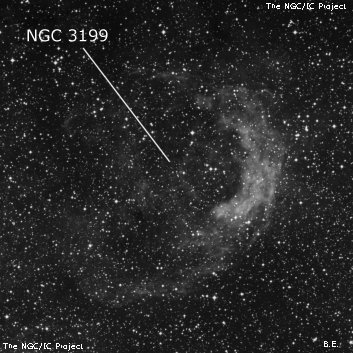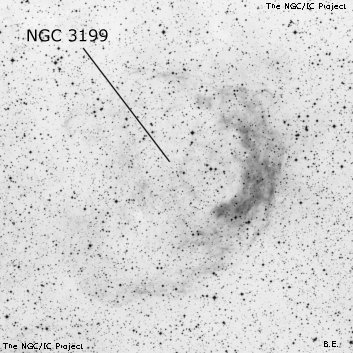NGC/IC Project Restoration Effort
(This is a very very beta version)
NGC3199


Basic Information
Location and Magnitude
Right Ascension: 10:17:24.0
Declination: -57:55:18
Constellation: CAR
Visual Magnitude:
Historic Information
Discoverer: Dunlop
Year of discovery: 1826
Discovery aperture: 9.0
Observational
Summary description: ! vB, vL, falcate, D * inv
Sub-type: EN
Corwin's Notes
=====
NGC 3199. Glen Cozens has found that this is Dunlop 332 with a one-degree
error in Dunlop's south polar distance (he put it 1 degree too far north).
JH rediscovered the object independently a decade later. He had the north
polar distance correct, so did not notice the identity with Dunlop's object.
The NGC object is the western part of a large, annular, HII region. I've
given an approximate center for that, as well as JH's three slightly different
positions for various stars within the 12' x 4' crescent that JH saw. I've
also given an approximate center for the entire 23' x 20' annulus. ESO did
the same thing, but estimated the center to be about 10 seconds of time west
of where I've put it. This may be because Andris Lauberts was looking at a
blue plate, while I'm restricted to the DSS2 red image. In any case, the
object is far enough south, and large enough, that the 10 second difference is
irrelevant to its identification and appreciation.
Steve's Notes
=====
NGC 3199
24" (4/11/08 - Magellan Observatory, Australia): at 200x and UHC filter this Wolf-Rayet bubble appeared as an amazing 180¡ crescent, open on the east side and forming a thick "C" shape. The rim of the bubble is widest on the western portion, although it is slightly brighter on the southwest side. The main portion of the crescent spans ~13' from the north to south end and appears ~3.5' thick in the middle, though fainter nebulosity spreads out to the southeast. A double star (h4302 = 10.4/11.6 at 23") is embedded near the south end. The surface brightness is fairly high overall, though irregular with slightly brighter patches, knots and streaks. A faint 5' linear streak or filament running SSW-NNE is superimposed along the outer western edge, though it separates or resolves from the Crescent at its north and south ends. The illuminating mag 10.6 Wolf-Rayet star (WR 18 = HD 89358) is located about 4' E of the center of the "C", and is asymetrically positioned with respect to the center of the entire shell. This W-R bubble is situated four degrees NW of the Eta Carina nebula in a rich Milky Way star field.
13.1" (2/17/04 - Costa Rica): at 105x and UHC filter, this HII region appears as a remarkable, huge crescent, roughly 11'x7' (the main region extends nearly 1/3 of the 39' field). Opens up towards the east in a huge "C" shape. The SW portion of the crescent is brightest, although the overall surface brightness is irregular with a mottled or curdled appearance. A few stars are superimposed even with the filter with the brightest stars at the SW end. Fainter nebulosity sprouts out of the SW end, increasing the total size by several arcminutes.
18" (7/8/02 - Magellan Observatory, Australia): this is an amazing HII region with a 20mm Nagler and UHC filter at 103x. It appears as a fairly bright, thick crescent opening towards the east, roughly 10'x6'! The surface brightness was quite irregular with a UHC filter and the nebulosity was noticeably brighter on the south end where a couple of brighter stars are embedded. Off the bright portion of the south end, much lower surface brightness haze extends the curve further SE for several arcmin and spreads out somewhat increasing the length to ~15'. The main mass has a curdled, mottled appearance and dark lanes appear to intrude into the nebulosity. The illuminating star HD 89358 is a Wolf-Rayet star (WR 18) and this nebulosity is reminiscent of the Crescent Nebula in Cygnus (it could be dubbed the "Southern Crescent").
9x50 finder (2/17/04 - Costa Rica): surprisingly, NGC 3199 was visible in the 50mm finder at just 9x by blinking with the OIII filter. An elongated bar of nebulosity was seen!



